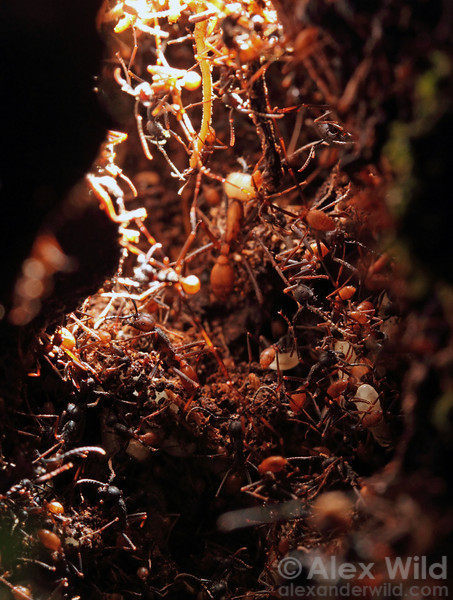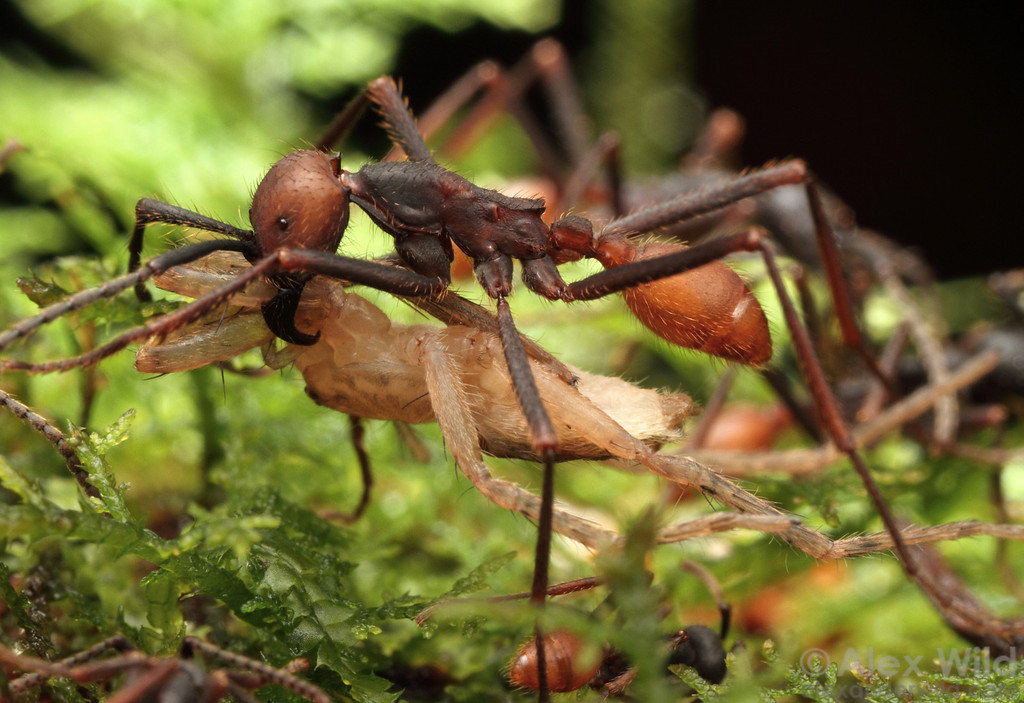Interactions
Eciton burchellii is a species of ant that is
considered a eusocial insect. Social evolution trends in
insect’s ranges from individual, but yet hard-wired and
high-grade processing units, like the
European Paper Wasp (Polistes dominula), to simpler
individuals with high numbers like Army Ants (Franks 1989). Each
colony is made up of over 500,000 individuals. These ants are
highly known for raiding and getting their prey using pure
numbers (Encyclopedia
of Life 2013). Due to their large colony size and
carnivorous habits they must often migrate in order to find food
for survival (Amateur
Entomologists’ Society 2013). These ants are able to
accomplish large goals by individuals spontaneously working
together, which is seen when forming bivouacs.

Over 300 confirmed species, mostly birds and insects, have
been
reported to associate with Army Ants and also depend on
them for
their existence. Most relations between species
involve the
predation and engulfing of other organisms
unfortunate enough to
be in the path of a raid. In the course of
a day, a single colony
may capture more than 30,000 prey items (Encyclopedia
of life
2013).
When in a raid, the ants form a fan shaped
network of
columns.
Trailing behind these fans are base columns
connecting
the raiders
with the bivouac. Swarmers have stronger
bites and
more potent
stings than column raiders and they attack
a wider
range of prey,
including hard bodied arthropods (Amateur
Entomologists' Society 2013). These organisms can be tarantulas,
scorpions, beetles (like
Oiceoptoma noveboracense), roaches, grasshoppers, and many other
species of
ants (like
Atta cephalotes). There have also been reports of larger species
falling victim to Eciton burchellii. These consisted of snakes,
lizards, and nestling birds (Wildscreen
2013). Most victims are completely engulfed, much like the
ants in this
video.
Some species form mutualistic, parasitic, and commensalistic
relationships with Eciton burchellii. Army Ant raids support a
community of diverse organisms, including birds that attend the
raids to collect prey(Kumar and O’Donnell 2007, Meisel 2006,
Encyclopedia of life 2013). One Army Ant-following bird, Phaenostictus meleannani, uses a series of networks involving
mated pairs that have zones to occupy. These birds locate the
Army Ant swarms and feed on the raids (Encyclopedia of life
2013). Many other species of birds prey on the arthropods that
flee from the raids of E. burchellii. With some species of
antbirds, parasitic relationships are made due to the cost of
consumption of arthropods. There are around 300 species of bird
that rely on the ant for survival and larger flocks of birds
make it harder for the Army Ant swarm raids to get food for the
colony (Kumar and O’Donnell 2007, Encyclopedia of life 2013).
There are hundreds of species that live hand- in-hand
with Army Ants. The Euxenister beetle is known to have a
specific relationship with E. burchellii. They live in the
bivouac and groom workers while feeding off broods. Other
species of mites are also found almost every Army Ant bivouac
(Encyclopedia of Life 2013, Animal Diversity 2012).
in-hand
with Army Ants. The Euxenister beetle is known to have a
specific relationship with E. burchellii. They live in the
bivouac and groom workers while feeding off broods. Other
species of mites are also found almost every Army Ant bivouac
(Encyclopedia of Life 2013, Animal Diversity 2012).
When involving humans with E. burchellii, the species does not
often come in contact but has a very painful sting and is very
aggressive when protecting the bivouac. E. burchellii can be
extremely beneficial when getting rid of household and
agricultural pests (Encyclopedia of Life 2013).
Go on to Form and Function
Go back to Reproduction